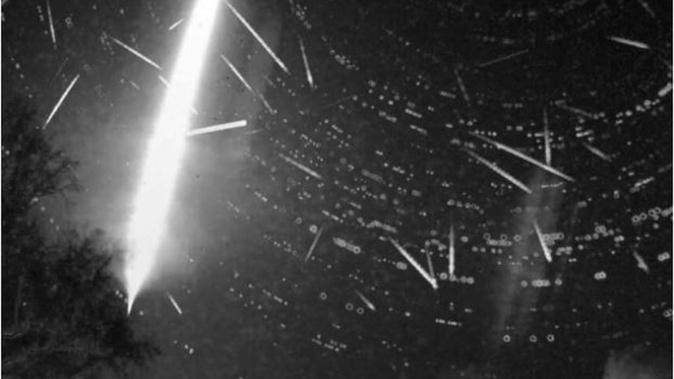
Scientists are searching for a meteorite that fell to the ground after a spectacular fireball lit up the sky over Otago on Sunday night.
The meteorite dropped somewhere southeast of Middlemarch and west of Outram near Dunedin, Fireballs Aotearoa scientists said.
The fireball was captured over central and east Otago at 10.50pm by five night-sky cameras deployed as part of Fireballs Aotearoa's mission to track down New Zealand meteorites.
Associate Professor James Scott from the University of Otago's Department of Geology recently deployed three of the five cameras with students and colleague.
/cloudfront-ap-southeast-2.images.arcpublishing.com/nzme/KSAWXYMTEQXTAMX5P33TMZVNXU.jpg)
The meteorite fell somewhere in the area southeast of Middlemarch and west of Outram. Image / Fireballs Aotearoa.
"It's stunning. The fireball was seen from Oamaru to Invercargill, and from Queenstown to Dunedin, and we are confident that it dropped between 1kg and 10kg of material southeast of Middlemarch - right in the middle of our network."
The other two fireball cameras that detected the meteor were based in Southland and operated by Fellow of the Royal Astronomical Society of NZ, Bob Evans.
Calculations by Dr Denis Vida from the Global Meteor Network showed the meteor sped in steeply from the west at about 15km/s and lasted over six seconds.
It decelerated to about 3km/s, at which point the bright flight stopped.
"This is a good sign because it means that meteorites survived until the end," Dr Vida said.
- NZ skies ready for celestial show of up to '20 meteors an hour'
- Potential meteor shower lights up New Zealand's skies
"A loud sonic boom followed the fireball, indicating a large size of the initial meteoroid entering the atmosphere."
Just nine confirmed meteorites have fallen in New Zealand over the past 150 years, with only two having been seen to "fall".
The last confirmed meteorite came through a roof in the Auckland suburb of Ellerslie in 2004 and originated from an asteroid, an area of rubble left over from early solar system.
The calculated trajectory of Sunday's meteoroid suggests the last one also came from the asteroid belt.
Astronomer Jeremy Taylor of Fireballs Aotearoa asked people not to trespass while looking for any meteorites.
"If you live in this area, please look out for dark shiny rocks in places they shouldn't be," Mr Taylor said.
"If you find a piece on your land or on a road, please let us know. Don't take any risks searching for it and don't go where you shouldn't."
Dr Michele Bannister from the School of Earth and Environmental Science at Canterbury University explained what people should look out for when hunting the meteorite.
"It'll have a distinct black surface from melting during its passage through the atmosphere," Dr Bannister said.
"Please photograph it in place: Note the location using your phone GPS and avoid touching it with your bare hands, the less contamination the better.
"Pick it up in fresh aluminium foil if possible, or otherwise a new clean plastic bag."
If you do find something out-of-place, then please send a photo and the coordinates to Prof. James Scott ([email protected]), who is co-ordinating the search for this rock, or via the contact page at www.fireballs.nz.
Take your Radio, Podcasts and Music with you









